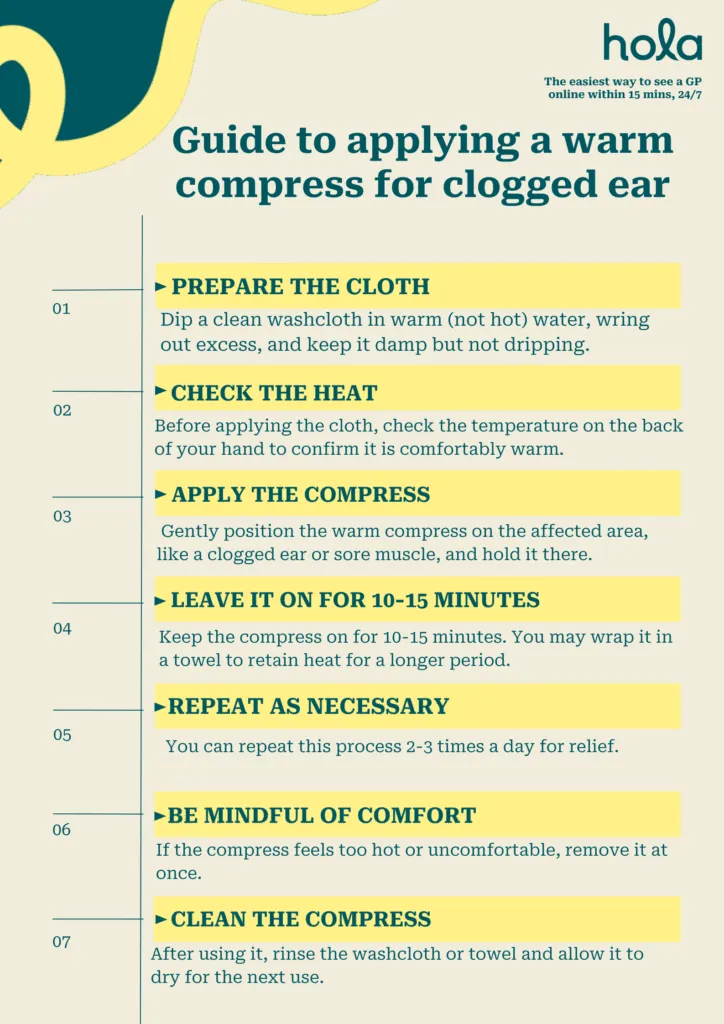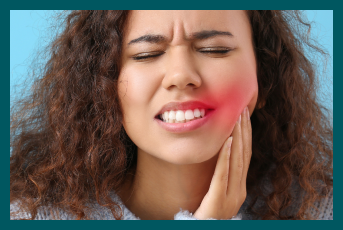Warm compress for clogged ear: What you need to know
Written by the editorial staff writer at Hola. Medically Reviewed by Dr. Ammar AL-ANI, MBChB, CCBST, AMC.

Contents

Summary: A warm compress may assist in alleviating a clogged ear by softening earwax, lessening pressure, or relieving sinus-related congestion. Place a warm, moist cloth against the impacted ear for 10 to 15 minutes. This is a straightforward and safe remedy, though it may not be effective for every cause. Consult a online doctor if symptoms continue, worsen, or are accompanied by pain or discharge
Ever experienced that annoying feeling like your ear is stuffed with cotton or everything sounds muffled, like you are underwater? Yes, that’s a clogged ear, and it can be distracting. Whether it’s from a cold, persistent sinus trouble, or buildup of earwax, the discomfort is real. But before you rush to the clinic or start poking around with cotton swabs (please don’t!), there is a simple and comforting remedy that may bring relief: a warm compress. Let’s explore how this gentle solution can help clear things up—literally.
What causes a clogged ear?
A clogged ear can be caused by several factors, including:- Earwax buildup
- Sinus congestion, colds, or allergies
- Blocked Eustachian tube
- Middle ear infections
- High altitudes
- Water trapped in the ear
Can a warm compress help a clogged ear?
Yes, a warm compress can help relieve a clogged ear, especially when the blockage is caused by sinus pressure, fluid accumulation, or mild earwax buildup.How does a warm compress work for ear blockage?
A warm compress works by:- Boosting circulation: The heat enhances blood flow, helping to reduce inflammation and promote healing.
- Softening earwax: Warmth helps soften stiff wax, making it easier to drain or remove naturally.
- Reducing sinus pressure: If a clogged ear is caused by sinus problems or Eustachian tube dysfunction, heat can help clear up the congestion and promote drainage.
- Relieving pain and discomfort: The heat helps relax the surrounding muscles and alleviates the tension caused by ear pressure or mild infections.
Is a warm compress effective for fluid or wax build-up?
Yes, a warm compress can be effective for both:- Fluid buildup: The heat helps open the Eustachian tubes, allowing trapped fluid to drain and reducing pressure.
- Earwax buildup: Heat softens hardened earwax, making it easier to naturally clear out or respond better to ear drops.
Feeling sick and unsure why? Speak with a GP online in 15 minutes.
See a Doctor now
Available 24/7, across Australia.
How to use a warm compress on a clogged ear safely
To safely apply a warm compress on a clogged ear, immerse a clean washcloth in warm (not hot) water and squeeze out the excess. Check the temperature to verify it’s warm enough, but not too hot to prevent burns. Gently place the compress against the affected ear for 10-15 minutes, repeating this 2-3 times a day. Lying down with the affected ear facing up can help loosen any blockage. If you experience discomfort or pain, take off the compress immediately. Avoid using it if there's any indication of infection, drainage, or damage to the ear. If the problem continues, please consult with a healthcare professional.Step-by-step guide to applying a warm compress
Here’s a detailed guide for using a warm compress:- Prepare the cloth: Dip a clean washcloth or towel in warm water. Ensure that the water is heated just enough to be warm, not hot, to prevent burns. Squeeze out any extra water so that the cloth remains damp but not dripping.
- Check the heat: Before applying the cloth, check the temperature on the back of your hand to confirm it is comfortably warm.
- Apply the compress: Gently position the warm compress on the affected area, like a clogged ear or sore muscle, and hold it there.
- Leave it on for 10-15 minutes: Keep the compress on for 10-15 minutes. You may wrap it in a towel to retain heat for a longer period.
- Repeat as necessary: You can repeat this process 2-3 times a day for relief. Re-soak the cloth in warm water for each application.
- Be mindful of comfort: If the compress feels too hot or uncomfortable, remove it at once.
- Clean the compress: After using it, rinse the washcloth or towel and allow it to dry for the next use.

How long should you keep the compress on?
You should maintain the warm compress for about 10-15 minutes at a time. This time is usually adequate to provide relief and assist with issues like clogged ears or muscle pain. If needed, you can redo the process 2-3 times a day, allowing the compress to cool in between uses.When a warm compress may not work
A warm compress may not be effective or could fail to alleviate discomfort in certain scenarios:- Infection: If the issue stems from an infection (such as an ear infection or skin infection), a warm compress may not be sufficient and could even exacerbate the situation.
- Intense pain or swelling: If the pain or swelling is severe, a warm compress might only offer temporary relief, necessitating further medical intervention.
- Blocked ears due to wax buildup: If the ear is blocked due to excessive earwax, using a warm compress may not suffice to clear the obstruction and a professional cleaning might be necessary.
- Skin issues: Using a warm compress in cases of open wounds, rashes, or burns, may irritate or worsen the condition.
- Incorrect temperature: If the compress is too hot or cold, it may cause discomfort or skin injury, leading to ineffective relief.
- Underlying health concerns: If the condition arises from an underlying health issue (like autoimmune disorders or chronic conditions), the warm compress may not tackle the core problem.
Other home remedies for a blocked ear
Here are additional home remedies for an ear blockage:- Warm olive oil: Carefully heat a few drops of olive oil and place them in the affected ear. This can assist in softening earwax and alleviating discomfort. Allow it to remain for a few minutes before tilting your head to let the oil drain out.
- Steam inhalation: Breathing in steam from a bowl of hot water can help loosen mucus or congestion causing the blockage. Drape a towel over your head and inhale the steam for approximately 10 minutes.
- Ear irrigation: Use a bulb syringe to gently flush warm water into the ear canal. This may aid in removing excess wax. Ensure the water is at a comfortable temperature and avoid using excessive pressure.
- Hydrogen peroxide: Combine a small amount of 3% hydrogen peroxide with an equal part of water and place a few drops in the affected ear. This can help dislodge wax and eliminate debris.
- Jaw movements: Yawning or chewing gum may help relieve pressure in the ears, particularly if the blockage is due to changes in air pressure, such as during flights or at high altitudes.
- Vinegar and rubbing alcohol: Blend equal amounts of white vinegar and rubbing alcohol. Place a few drops in the ear to help dry up moisture and loosen wax.
- Warm compress: As mentioned earlier, applying a warm compress to the affected ear can reduce discomfort and swelling if the blockage is caused by congestion or fluid accumulation.
Medical treatment options for persistent ear blockage
If home remedies fail to resolve a persistent ear blockage, various medical treatment options may be recommended by a healthcare provider:- Manual wax removal: A healthcare provider might employ specialised instruments such as a curette or suction device to extract impacted wax that is causing the blockage.
- Medications: If the blockage results from infection or inflammation, a doctor may prescribe ear drops that contain antibiotics, steroids, or wax softeners.
- Myringotomy: In more severe or recurring cases where fluid builds up behind the eardrum, a small incision might be made to facilitate fluid drainage.
- Surgical intervention: In rare instances where the blockage is due to structural issues, such as tumours or abnormal growths, surgery may be necessary to address the problem.
How can telehealth help with clogged ears?
Telehealth appointments 24/7 make it easy to consult a doctor about clogged ears without leaving home. Through a video or phone consultation, a doctor can assess symptoms like ear pain, pressure, or hearing changes. If needed, they can issue a doctor medical certificate. You can also receive online scripts for ear drops or medications, plus online referrals to an ENT specialist if further care is required. Many services even offer medicine delivery, ensuring fast, convenient treatment. Telehealth provides safe, expert care for ear issues anytime, from the comfort of your home.Signs you need to see a doctor for ear blockage
Here are indications that you should consult a doctor regarding ear blockage:- Severe or persistent pain: If the blockage is associated with significant or continuous pain, it may suggest an infection or another serious condition.
- Hearing loss: Experiencing partial or complete hearing loss in one or both ears should be assessed by a healthcare professional.
- Ear discharge: Fluid, pus, or blood leaking from the ear could indicate an infection or injury that requires medical intervention.
- Fever: A fever occurring alongside ear blockage may suggest an underlying infection.
- Dizziness or balance issues: If you face vertigo or difficulty maintaining balance, the problem could be linked to the inner ear and necessitates medical evaluation.
Conclusion
A warm compress might not be magic, but it comes pretty close when your ear feels blocked and uncomfortable. It’s safe, easy to use, and relaxing, just what your ears need. And if the clog doesn’t clear, no worries, your healthcare provider is there to help you.FAQs
Does a warm compress help a clogged ear?
Yes, applying gentle heat to a blocked ear can bring comforting relief by:- Improving circulation
- Softening earwax
- Reducing sinus and Eustachian-tube congestion
- Soothing pain or discomfort
Where should I place a warm compress for ear blockage?
Place a warm compress on the outer ear and just behind it, on the same side of your head. This targets the ear canal and the Eustachian tube, helping to soften earwax, reduce pressure, and improve fluid drainage.Can I use a hot water bottle or heating pad instead?
Yes, both a hot water bottle and a heating pad can be used as alternatives to a warm compress. Just ensure to:- Wrap them in a towel to prevent direct contact with skin.
- Use low to medium heat to avoid burns.
- Apply for 10-15 minutes over the affected area.
Is it safe to apply heat to the ear if it’s infected?
Using mild heat on the infected area can be safe and soothing, especially for easing pain and promoting drainage. However:- Use low heat only, never too hot.
- Avoid applying pressure to a swollen or draining ear.
- Avoid using heat if there is a ruptured eardrum or pus discharge from the ear.
How many times a day can I use a warm compress on a clogged ear?
It is safe to apply a warm compress on a clogged ear 2 to 3 times a day. Each session should last about 10-15 minutes. This helps ease pressure, loosen earwax, and promote drainage without irritating the ear or surrounding skin. Always allow your skin to cool before repeating the process.How long will it take for a warm compress to unclog my ear?
Relief may happen within minutes or take a few hours, depending on the underlying cause. For issues like sinus pressure or mild fluid buildup, a warm compress can provide fairly quick results. If the blockage is due to earwax, it may require multiple sessions over a day or two. If there’s no improvement after a few days, it’s best to consult a healthcare provider.Can I combine a warm compress with other remedies?
Yes, a warm compress can be safely combined with other remedies for better results, depending on the cause of the blockage. Common combinations include:- Steam inhalation to ease sinus pressure
- Over-the-counter ear drops for softening earwax
- Hydration to thin mucus and promote drainage
Get your prescription online within
15 minutes, anytime, anywhere.
15 minutes, anytime, anywhere.
Request an instant script
Available 24/7, across Australia.
What we treat
- Cough
- Nausea & vomiting
- Fever
- Hayfever
- Fatigue
- Sore throat
- Acne
- Hair loss
- Gout
- Eczema
- Rosacea
- Sunburn
- UTI
- Erectile dysfunction
- Contraception
- Morning sickness
- Morning after pill
- Prostate health
- Anxiety
- Depression
- Stress
- Grief & loss
- Antidepressants
- Premature ejaculation
- Asthma
- Blood pressure
- Blood thinners
- Diabetes
- Cholesterol
- Migraines & headaches
- Allergies
- Body ache
- Heartburn & reflux
- Sleep disorder
- Pain relief
- Gastro
Related Articles
Disclaimer
This blog is for general informational purposes only and does not indicate that Hola Health provides all treatments or preventive measures mentioned. It is not intended to be a substitute for professional medical advice. Always seek the guidance of your doctor or other qualified health professional with any questions you may have regarding your health or a medical condition. For emergencies please immediately contact 000. Any medical topics discussed are intended to educate, not to imply availability through Hola Health.
 Facebook
Facebook  X
X  Copy Link
Copy Link



